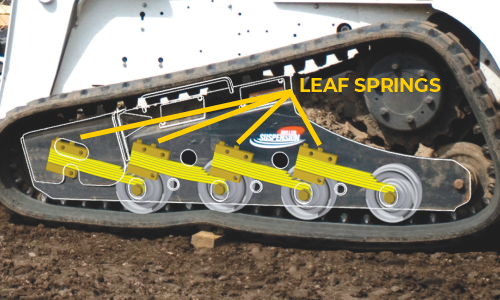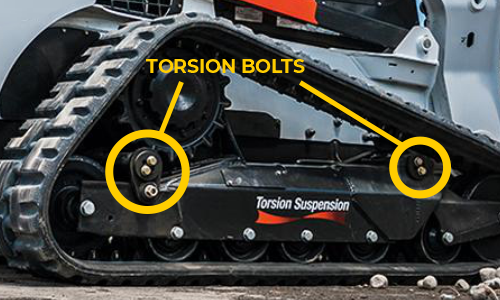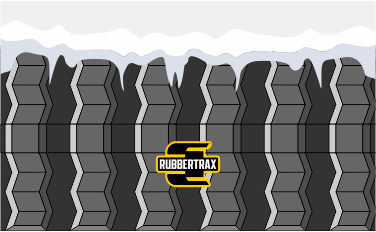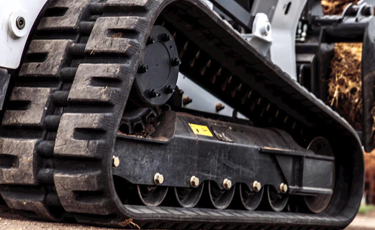Understanding your CTL Suspension and Undercarriage System
Compact track loader operators have been spoiled over the past few years as more and more creature comforts are created to reduce “operator fatigue”. Closed cabs with air conditioning, radios, electronics and safety functions have certainly improved the life of a grading contractor over the years. There are more extensive, and expensive upgrades to significantly reduce operator fatigue and reduce damage caused by vibrations and impacts. Every compact track loader manufacturer is looking for the next best invention to improve the track loader undercarriage from the bottom up. This is a brief review and summary of the current undercarriage systems offered by many manufacturers such as Bobcat and Caterpillar. There are three options so we will focus on those three options since the undercarriage parts from each system seem vary depending on the exact setup. In fairness to the hard working operators that work in extreme conditions, I will point out that the suspension systems are very effective in maintaining much better control of the contents of the bucket, so it’s not totally about comfort. Extensive documentation is provided by Bobcat on their main website for comparison purposes. Our information is more geared to educate the consumer that there are significant differences in each roller. You can’t simply call and day “give me a T-650 bottom roller”. There are serial number breaks, and completely different undercarriage part options for several models.
Historically, all Bobcat track loader models use an undercarriage built with a “Solid Mount” system which means the rollers and idlers bolt into place on the track frame with no form of flexibility or shock suspension. In fact, just the term bolt-on varies because many of the original models used a slotted track frame where the post from the bottom rollers slipped in from the bottom and tightened with a nut. Now almost every model utilizes a bolt that mounts directly through a hole in the track frame which eliminates any risk of the roller slipping out of the track frame.
 As operator comfort became a priority and companies like Caterpillar introduced suspension systems similar to the original ASV torsion systems, Bobcat tried to find a way to compete. When the loader series switched from the T-300 and T320 series to the T590 and T650 series, Bobcat introduced their first attempt at a suspension system called "Roller Suspension". It worked by placing leaf springs on the rollers and idlers. As seen in the graphic illustration, the suspension system is indicated on the side of the undercarriage with a large "Roller Suspension" emblem, but when you look through the bolt holes you can see the leaf springs. For the T550, T590, T630, and T650 series; the rollers are slightly different and are not interchangeable. You must verify with a serial number and confirmation by the user to determine which rollers to send in each case. The T450 only comes in the “Solid Mount”, now referred to as “Rigid” undercarriage.
As operator comfort became a priority and companies like Caterpillar introduced suspension systems similar to the original ASV torsion systems, Bobcat tried to find a way to compete. When the loader series switched from the T-300 and T320 series to the T590 and T650 series, Bobcat introduced their first attempt at a suspension system called "Roller Suspension". It worked by placing leaf springs on the rollers and idlers. As seen in the graphic illustration, the suspension system is indicated on the side of the undercarriage with a large "Roller Suspension" emblem, but when you look through the bolt holes you can see the leaf springs. For the T550, T590, T630, and T650 series; the rollers are slightly different and are not interchangeable. You must verify with a serial number and confirmation by the user to determine which rollers to send in each case. The T450 only comes in the “Solid Mount”, now referred to as “Rigid” undercarriage.
 After a few years of the suspension system Bobcat released a torsion system called "Torsion Suspension". Caterpillar already offered all of their machines in a torsion system but it does not affect the undercarriage parts. The Bobcat torsion system is also clearly indicated by a sticker on the side of the undercarriage that says "Torsion Suspension", but if the sticker is worn off you can see the torsion bars by looking at a side view of the undercarriage. Although the rollers are solid mounted, the torsion bars rotate to absorb the shock for the operator. The torsion bars appear to be additional rollers at first glance but this side view gives you an indication of what to look for to determine if the user has a torsion system versus a suspension system.
After a few years of the suspension system Bobcat released a torsion system called "Torsion Suspension". Caterpillar already offered all of their machines in a torsion system but it does not affect the undercarriage parts. The Bobcat torsion system is also clearly indicated by a sticker on the side of the undercarriage that says "Torsion Suspension", but if the sticker is worn off you can see the torsion bars by looking at a side view of the undercarriage. Although the rollers are solid mounted, the torsion bars rotate to absorb the shock for the operator. The torsion bars appear to be additional rollers at first glance but this side view gives you an indication of what to look for to determine if the user has a torsion system versus a suspension system.
If you are buying a Bobcat then you have the choice of which undercarriage to choose on most of the models.The T450 is a rigid mount only and the T870 comes with the torsion system by default but all of the 500, 600, and 700 series have options. Although the undercarriage parts are not related to the torsion system and only the rollers are effected in the leaf spring suspension system, there seem to be a wide variety of undercarriage parts on these three series that must be verified by specifying your complete model, serial number, single speed or two speed, and verifying which undercarriage type you have among the three options. The Caterpillar undercarriage parts are quite straight forward and all we need is a make and model to determine which parts you need. The only variance in the Caterpillar CTL undercarriage happens in some of the XHP models when you run into the triple flange idlers instead of a dual flange idler. The bottom rollers are triple flange on each Caterpillar CTL undercarriage from the 239/249 series all the way through the 299D. Don’t confuse the Caterpillar MTL series, that a topic for a different day.
Now that you know all about the history and differences in CTL suspension undercarriage systems, please reach out to one of our experienced Rubbertrax team members with any questions you might have about a T-650 Solid Mount versus T-650 Suspension Mount undercarriage.


